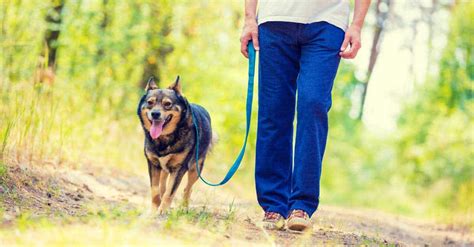Master leash training with tips on selecting the right leash, teaching walking by your side, positive reinforcement, troubleshooting common issues, and enjoying stress-free walks with your dog.
Understanding Leash Training Basics
Understanding Leash Training Basics
Leash training basics are essential for any dog owner looking to enjoy stress-free walks with their furry friend. The first step in leash training is to select the right leash and collar for your dog’s size and breed. It’s important to choose a leash that is sturdy and comfortable for both you and your dog. The collar should fit snugly around your dog’s neck without causing any discomfort. Once you have the right equipment, it’s time to start teaching your dog to walk by your side.
Teaching your dog to walk by your side requires patience and consistency. Start by letting your dog get used to wearing the collar and leash indoors. Use positive reinforcement techniques such as treats and praise to encourage your dog to stay by your side as you walk around the house. Gradually move to practicing in your yard or a quiet outdoor area, using the same rewards to reinforce good behavior. Remember to always use gentle guidance and avoid jerking the leash, as this can cause discomfort and confusion for your dog.
Handling pulling and tugging is a common challenge when leash training a dog. It’s important to address this behavior with patience and positive reinforcement. When your dog pulls on the leash, stop walking and wait for them to relax and come back to your side. Reward them for walking calmly, and continue walking once they are in a comfortable position. Consistent practice and positive reinforcement will help your dog understand the importance of walking by your side, leading to enjoyable and stress-free walks for both of you.
Selecting the Right Leash and Collar
When it comes to selecting the right leash and collar for your dog, it’s important to consider the specific needs of both you and your pet. The leash and collar you choose can greatly impact your dog’s comfort and behavior during walks, so it’s essential to make an informed decision.
First and foremost, consider the size and strength of your dog. Larger, stronger dogs may require a thicker, more durable leash and collar to ensure they remain secure and comfortable during walks. On the other hand, smaller dogs may do well with a lighter, more flexible option.
In addition, take into account any specific behavioral or health concerns your dog may have. For instance, if your dog tends to pull or lunge during walks, a harness may be a better option than a traditional collar. Likewise, if your dog has neck or throat sensitivity, a padded collar may be more suitable.
Teaching Your Dog to Walk by Your Side
Teaching your dog to walk by your side is an essential skill for both the safety of your pet and your own peace of mind. It’s important to establish a strong bond with your dog, and leash training is a great way to do that. When you first start training your dog to walk by your side, it’s important to choose the right equipment. Make sure to use a proper collar and leash that is comfortable for your dog. You can also use a harness if your dog is prone to pulling. The key to getting your dog to walk by your side is to make sure they understand that it’s a positive experience.
During your training sessions, use positive reinforcement techniques such as treats and praise to encourage your dog to stay by your side. Start in a quiet, low-distraction environment and gradually increase the level of distraction as your dog becomes more adept at walking by your side. Be patient and consistent with your training, as it may take time for your dog to fully understand what is expected of them. It’s also important to be aware of your body language and to keep a relaxed, confident posture while walking with your dog.
If your dog starts to pull or drift away, gently redirect them back to your side and reward them when they comply. Consistency is key in teaching your dog to walk by your side, so be sure to practice regularly and remain calm and assertive during your training sessions. With time and patience, your dog will learn to walk by your side, making your walks together a stress-free and enjoyable experience for both of you. Remember, leash training is a process that takes time and effort, but the rewards of having a well-behaved and obedient dog are well worth it.
Handling Pulling and Tugging
One of the common challenges dog owners face when leash training their furry friends is handling pulling and tugging. It can be frustrating and overwhelming when your dog constantly pulls at the leash, making it difficult for you to maintain control during walks.
When dealing with pulling and tugging, it’s important to stay patient and consistent with your training efforts. Positive reinforcement techniques can be highly effective in teaching your dog to walk calmly by your side without pulling. Use treats, praise, and rewards to encourage good behavior during walks.
Additionally, consider using a front-clip harness or head halter to discourage pulling. These tools provide better control and redirect your dog’s attention back to you, making it easier to handle pulling and tugging. With consistent training and the right gear, you can overcome this common leash training issue and enjoy stress-free walks with your dog.
Practicing Positive Reinforcement Techniques
Practicing Positive Reinforcement Techniques
How to Properly Leash Train Your Dog for a Stress-Free Walk
When it comes to leash training your dog, positive reinforcement techniques can be incredibly effective. Instead of punishing your dog for pulling or tugging on the leash, focus on rewarding good behavior. This means using treats, praise, and other rewards to encourage your dog to walk nicely by your side. By consistently reinforcing the behavior you want, you can help your dog understand what is expected of them during walks.
One of the most important positive reinforcement techniques to use during leash training is clicker training. This involves using a clicker to mark the moment your dog performs the desired behavior, followed by a reward. The clicker helps to communicate to your dog exactly when they have done something right, making the reward more effective. With consistent use, your dog will learn to associate the sound of the clicker with positive reinforcement, making leash training more successful.
In addition to clicker training, it’s important to be consistent with your rewards. Every time your dog walks nicely by your side, be sure to reward them with treats, praise, or playtime. This will help to reinforce the behavior and encourage your dog to continue walking politely on the leash. Remember to be patient and consistent, as mastering positive reinforcement techniques takes time and practice.
Troubleshooting Common Leash Training Issues
One common issue that dog owners may face during leash training is pulling and tugging. This behavior can be frustrating and make walks unpleasant for both the owner and the dog. One way to address this issue is to teach the dog to walk by your side using positive reinforcement techniques. By rewarding the dog for walking calmly beside you, you can help to eliminate the pulling and tugging behavior over time.
Another common issue that may arise during leash training is selecting the right leash and collar. If the equipment is uncomfortable or ill-fitting, it can make the training process much more difficult. It’s important to choose a leash and collar that are appropriate for your dog’s size and breed, and to ensure that they are properly fitted. Taking the time to find the right gear can make a big difference in the success of the training process.
One more common issue that dog owners may encounter during leash training is enjoying a stress-free walk with your dog. If the dog is anxious or fearful during walks, it can make the experience stressful for both the owner and the dog. In this case, it’s important to work on desensitizing the dog to the triggers that cause stress, and to gradually build up their confidence and comfort levels. By addressing these common issues, owners can troubleshoot their leash training problems and work towards enjoying peaceful and enjoyable walks with their dog.
Enjoying a Stress-Free Walk with Your Dog
Leash training is a crucial part of ensuring that you and your dog have an enjoyable and stress-free walk. By understanding the basics of leash training, selecting the right leash and collar, and using positive reinforcement techniques, you can teach your dog to walk by your side without pulling or tugging.
When it comes to leash training, selecting the right leash and collar is essential. A standard six-foot leash made of nylon or leather is a good option for most dogs. Additionally, choosing a collar that fits your dog properly and is comfortable for them to wear is important. Whether you choose a flat collar, martingale collar, or harness, make sure it allows you to maintain control without causing any discomfort to your dog.
Teaching your dog to walk by your side and handle pulling and tugging requires patience and consistency. Using positive reinforcement techniques, such as rewarding your dog with treats or praise when they walk nicely on the leash, can help them understand what behavior is expected. It’s important to practice these techniques regularly and be patient with your dog as they learn to walk calmly by your side.
Frequently Asked Questions
Why is leash training important for dogs?
Leash training is important for dogs to ensure they can safely and effectively go on walks without pulling or causing harm to themselves or their owners.
What equipment do I need for leash training my dog?
You’ll need a properly fitted collar or harness, a sturdy leash, and possibly treats or rewards for positive reinforcement.
What are some common mistakes to avoid when leash training a dog?
Common mistakes to avoid include using a retractable leash, allowing the dog to pull on the leash, and not being consistent with training.
How can I teach my dog to walk calmly on a leash?
You can teach your dog to walk calmly on a leash by using positive reinforcement, teaching them to focus on you, and practicing in low-distraction environments.
Should I use a choke or prong collar for leash training?
It’s best to avoid using choke or prong collars for leash training, as they can cause pain and injury to the dog. Opt for a properly fitted harness or collar instead.
How long does it take to leash train a dog?
The time it takes to leash train a dog varies based on the individual dog and their previous experiences. Consistent training and patience are key factors in successful leash training.
What are the benefits of a properly leash trained dog?
A properly leash trained dog can enjoy stress-free walks, have better obedience, and build a stronger bond with their owner.





